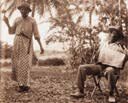The road that led to Toco

By KIM JOHNSON
September 20, 1998
IN the preface to Trinidad Village, their book that would later become famous, Melville and Frances Herskovits explained what led to their undertaking to study the people of Toco:
"In 1929, returning from field-work among the Bush Negroes of Dutch Guiana, we spent several days in Port of Spain, Trinidad, waiting for a ship to take us to the United States. In a local newspaper we came upon a letter from an aroused citizen expressing indignation at certain practices then being carried on near the capital by Negroes who were worshippers of Shango. We forthwith promised ourselves to come back to Trinidad after we had finished the field-work in West Africa that had been arranged for the following year, and investigate this Shango worship and the ways of life of the people who carried it on. For we knew it could only derive from the Yoruban peoples of Nigeria, and must represent an important body of direct African cultural retentions.
"Ten years were to pass before we found ourselves in Trinidad, ready to undertake the study we had outlined in our minds on the basis of the letter in the Trinidad Guardian. Because Shango worship was so near the capital, we thought it evident that this cult, and the African ways of life we assumed to be associated with it, would be met in greatest purity in the districts remote from this centre of European contact. The choice of a community removed from Port of Spain was thus the first requisite, the second, that it be small enough so that we might come to know it well.
"Contrary to all our expectations, however the remote community where we worked proved to be without Shango worship-without, indeed, any more Africanisms than would be found in almost any rural Negro community in southern United States. Yet the materials it eventually yielded, as if casting a sudden flare against indistinct masses, silhouetted for us in clear outline the means whereby transitions from African custom to ways of life preponderantly European had been achieved by Africans and their descendants. The Shouters sect, for example, revealed how African worship, as exemplified in present-day Trinidad in the Shango cult that we were later able to study in Port of Spain had been shaped and reinterpreted to fit into the pattern of European worship. The institution of "keepers" the form of Trinidad common-law marriage that resembles extra-legal Negro matings in all the New World, was seen to be a reconciliation of European monogamic institutions and African relationship groupings based on broader definitions of kinship and plural marriage. The transformation of Sankey and Moody hymns into "shouts" was found to represent a parallel point of transition in musical style."
Once back on the island there was great interest in their project, for which the field work was made possible by a grant from the Carnegie Corporation of New York, and assistance with their data provided by the Graduate School of Northwestern University.
"In Trinidad itself, we count ourselves fortunate in having had the fullest cooperation of the Colonial Government, then headed by His Excellency, Sir Hubert Young, who showed sympathy towards the ethnological approach, and deep understanding of the aims of our research.
"Our friends, Mr Edward MacEchrane and Mr James A Bain were sparing of no effort in helping us resolve some of the practical problems of getting settled to carry on with our work. In Toco we were the recipients of many courtesies from Mrs Albert Monsegui(sic), and of the aid of Sergeant Dash, head of the police department there. The many villagers who came to be our friends, and to whom we owe whatever insight these pages may hold, we must leave unnamed as is their wish.
"The freedom with which these men and women described their beliefs, their aspirations and discontents, contained an implicit awareness that we would not make light of the realities of the situation of village life nor or colonial attitudes."
The Herskovits' also paid tribute to Dr Richard A Waterman for allowing the transcription he made of a Sankey hymn to be included in their work, journalist Charles S Espinet "for clarifying the picture of wartime economic conditions on the island" and for securing the services of the well-known photographer Conrad Bennett who was also a native of Toco.
END






